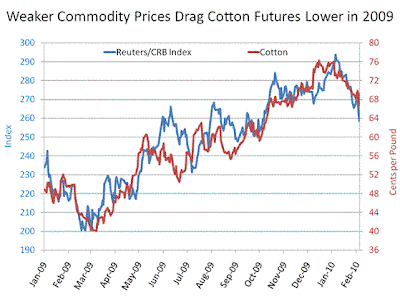
for more analysis like this, please click here.
ICE U.S. cotton futures rocketed ahead for the second straight week, capping off nine consecutive days of higher closes on the robust outlook for bullish fundamentals in the next marketing year. The nearby soared 440 points for the week to 78.79 by Friday, the highest weekly close since its March 2008 spike. At the 2010 Ag Outlook Forum just outside Washington, DC last week, USDA analysts speculated that bullish fundamentals both in the U.S. and worldwide will persist into the new marketing year. Giving its first peek at a new-crop balance sheet, the USDA looks for global mill demand to outpace production for the fifth straight year, resulting in another decline in ending stocks in 2010/11. This would mean a world stocks-to-use ratio of 41.8%, down from 45.1% estimated for 2009/10 and the lowest since 1994/95, presumably boosting prices next year. Already, the marketing year-to-date average ‘A’ Index price is 75.0 cents per pound, with prices surpassing 83 cents by late February.
Echoing sentiment expressed earlier by others, the USDA believes the U.S. crop is likely to rebound from its lowest level in a quarter century on the outlook for a big jump in plantings and presumed normal yields across the cotton belt. Already, the most year-to-date precipitation in years has fallen around Lubbock here, boosting optimism for higher yields. But higher offtake may absorb the jump in production, leaving domestic ending stocks little changed. This year’s stocks-to-use ratio of 21% is projected to remain about the same in 2010/11, implying prices are likely to remain robust. The USDA projects the marketing year average U.S. price at 64 cents, compared with 62 cents for 2009/10.
While a myopic view of the fundamentals strongly points to even higher prices, we are cautious over the long term, as even higher prices may limit the number of mills able to pay these rates. As most any textile mill will acknowledge, downstream price pressures ensure that the only thing worse than high prices is volatile prices. And this marketing year has been full of both so far, hindering mills’ ability to forward price yarn quotes for remunerative—but still competitive—price points. Since beginning the marketing year at roughly 63 cents per pound, nearby prices are up almost 40% in less than six months. And while market fundamentals may point to continued gains in prices longer term, mills are unlikely to see remunerative prices paid for yarns, impacting both cotton share and viability for many. To avoid this dismal scenario, we encourage you to speak with one of our risk management consultants here to review your exposure to risk and see how we may be able to minimize this exposure for you.


